Effect of Concrete Micro-Mechanical Properties under the Coupled Corrosion of Sulfate and High Water Head
Abstract
:1. Introduction
2. Materials and Methods
2.1. Preparation of Test Materials
2.2. Principle and Test Method of Micro-Indentation
3. Establishment of Numerical Method
3.1. Elastoplastic Damage Model
3.2. Sulfate Corrosion Model
3.3. Seepage Diffusion Model
4. Result
4.1. Micro-Indentation Test Results
4.1.1. Micro-Indentation Test Results at the Same Corrosion Depth (0–3 mm Corrosion Area)
4.1.2. Micro-Indentation Test Results at Different Corrosion Depths
4.2. Numerical Simulation Results
5. Discussion
5.1. Micro-Indentation Test Discussion
5.2. Numerical Simulation Discussion
6. Conclusions
Author Contributions
Funding
Conflicts of Interest
References
- Idiart, A.; Laviña, M.; Cochepin, B.; Pateau, A. Hydro-chemo-mechanical modelling of long-term evolution of bentonite swelling. Appl. Clay Sci. 2020, 195, 105717. [Google Scholar] [CrossRef]
- Yue, Z.W.; Li, P.J.; Yang, B. The calculation of chloride ion transport in concrete under convection condition is considered. J. Tongji Univ. 2015, 43, 60–66. [Google Scholar]
- Tan, B.H. Study on Chloride Ion Transport Mechanism of Submarine Tunnel Concrete under Multi-Salt and Multi-Field Coupling; East China Institute of Technology: Fuzhou, China, 2018. [Google Scholar]
- Liu, Y. Experimental Study on the Performance of Tunnel Lining Concrete Under the Action of “Seepage and Stress Field” and Double Factors; Jiangsu University of Science and Technology: Zhenjiang, China, 2018. [Google Scholar]
- Liu, R.X. Study on Damage and Fracture Mechanism of Concrete under Sulfate Erosion and High Strain Rate Loading; China University of Mining and Technology: Xuzhou, China, 2019. [Google Scholar]
- Zhao, E.F.; Wu, C.Q.; Wang, S.W.; Hu, J.; Wang, W.Q. Seepage dissolution effect prediction on aging deformation of concrete dams by coupled chemo-mechanical model. Constr. Build. Mater. 2020, 237, 117603. [Google Scholar] [CrossRef]
- Jia, S.P.; Chen, W.Z.; Yu, H.D.; Li, X.L. Research on seepage-stress coupling damage model of Boom clay during tunneling. Rock Soil Mech. 2009, 30, 19–26. [Google Scholar]
- Khanzaei, P.; Samali, B.; Zhang, C. Coupled and uncoupled seepage-stress analysis of roller compacted concrete dams. ISH J. Hydraul. Eng. 2017, 23, 92–101. [Google Scholar] [CrossRef]
- Gu, W.; Yao, Z. Evaluation of surface cracking in micron and sub-micron scale scratch tests for optical glass BK7. J. Mech. Sci. Technol. 2011, 25, 1167–1174. [Google Scholar] [CrossRef]
- Karine, V.; Sandrine, M.; Denis, D.; Gilbert, F.; Fransois, S. Determination by nano-indentation of elastic modulus and hardness of pure constituents of Portland cement clinker. Cem. Concr. Res. 2001, 31, 555–561. [Google Scholar]
- Constantinides, G.; Ulm, F.J.; Van Vliet, K. On the use of nanoindentation for cementitious materials. Mater. Struct. 2003, 36, 191–196. [Google Scholar] [CrossRef]
- Ramachandra, A.; Iyer, N.R.; Prasad, B.K.R. Characterization and Evaluation of Micro-mechanical Properties of Ultra High Strength Concrete by using Micro-indentation Test. J. Inst. Eng. 2016, 97, 1–8. [Google Scholar]
- GB 175-2007. Common Portland Cement; AQSIQ, SAC: Beijing, China, 2007. [Google Scholar]
- GB/T 1596-2005. Fly Ash Used for Cement and Concrete; General Administration of Quality Supervision, Inspection and Quarantine of the People’s Republic of China: Beijing, China, 2005. [Google Scholar]
- GB/T 18046-2008. Ground Blast Furnace Slag Powder for Cement and Concrete; General Administration of Quality Supervision, Inspection and Quarantine of the People’s Republic of China: Beijing, China, 2008. [Google Scholar]
- GB/T 14685-2011. Pebble and Crushed Stone for Construction; General Administration of Quality Supervision, Inspection and Quarantine of the People’s Republic of China: Beijing, China, 2011. [Google Scholar]
- GB/T 50082-2009. Standard for Test Methods of Long-Term Performance and Durability of Ordinary Concrete; Ministry of Housing and Urban-Rural Development: Beijing, China, 2009. [Google Scholar]
- ISO 14577-1-2015. Metallic Materials—Instrumental Indentation Test for Hardness and Material Parameters; ISO: Geneva, Switzerland, 2015. [Google Scholar]
- Oliver, W.C.; Pharr, G.M. An improved technique for determining hardness and elastic modulus using load and displacement sensing indentation experiments. J. Mater. Res. 1992, 7, 1564–1583. [Google Scholar] [CrossRef]
- Hu, D.; Zhou, H.; Zhang, F.; Shao, J. Modeling of Short- and Long-Term Chemomechanical Coupling Behavior of Cement-Based Materials. J. Eng. Mech. 2014, 140, 206–218. [Google Scholar] [CrossRef]
- Oztekin, E.; Pul, S.; Husem, M. Experimental determination of Drucker-Prager yield criterion parameters for normal and high strength concretes under triaxial compression. Constr. Build. Material. 2016, 112, 725–732. [Google Scholar] [CrossRef]
- Moreno-Juez, J.; Tavares, L.M.; Artoni, R.; Carvalho, R.M.d.; da Cunha, E.R.; Cazacliu, B. Simulation of the Attrition of Recycled Concrete Aggregates during Concrete Mixing. Materials 2021, 14, 3007. [Google Scholar] [CrossRef]
- Sucharda, O.; Mateckova, P.; Bilek, V. Non-linear analysis of an RC beam without shear reinforcement with a sensitivity study of the material properties of concrete. Slovak J. Civil Eng. 2020, 28, 33–43. [Google Scholar] [CrossRef]
- Kupfer, H.B.; Gerstle, K.H. Behavior of Concrete under Biaxial Stresses. J. Eng. Mech. 1973, 99, 853–866. [Google Scholar]
- Hu, D.; Zhu, Q.; Zhou, H.; Shao, J. A discrete approach for anisotropic plasticity and damage in semi-brittle rocks. Comput. Geotech. 2010, 37, 658–666. [Google Scholar] [CrossRef]
- Budiansky, B.; O’Connell, R.J. Elastic moduli of a cracked solid. Int. J. Solids Struct. 1976, 12, 81–97. [Google Scholar] [CrossRef]
- Tixier, R.; Mobasher, B. Modeling of Damage in Cement-Based Materials Subjected to External Sulfate Attack. II: Comparison with Experiments. J. Mater. Civil Eng. 2003, 15, 314–322. [Google Scholar] [CrossRef]
- Ikumi, T.; Cavalaro, S.H.P.; Segura, I.; Aguado, A. Alternative methodology to consider damage and expansions in external sulfate attack modeling. Cement Concr. Res. 2014, 63, 105–116. [Google Scholar] [CrossRef] [Green Version]
- Sun, C.; Chen, J.; Zhu, J.; Zhang, M.; Ye, J. A new diffusion model of sulfate ions in concrete. Constr. Build. Mater. 2013, 39, 39–45. [Google Scholar] [CrossRef]
- Bentz, D.P.; Clifton, J.R.; Ferraris, C.F.; Garboczi, E.J. Transport Properties and Durability of Concrete: Literature Review and Research Plan; National Institute of Standards and Technology: Gaithersburg, MD, USA, 1999. [Google Scholar]
- Yu, C.; Sun, W.; Scrivener, K. Mechanism of expansion of mortars immersed in sodium sulfate solutions. Cem. Concr. Res. 2013, 43, 105–111. [Google Scholar] [CrossRef]
- Atkinson, A.; Haxby, A.; Hearne, J.A. The Chemistry and Expansion of Limestone-Portland Cement Mortars Exposed to Sulphate Containing Solutions; United Kingdom Nirex: Oxfordshire, UK, 1988. [Google Scholar]
- Abed, A.A.; Sołowski, W.T. A study on how to couple thermo-hydro-mechanical behaviour of unsaturated soils: Physical equations, numerical implementation and examples. Comput. Geotech. 2017, 92, 132–155. [Google Scholar] [CrossRef]
- Coussy, O. Poromechanics; John Wiley & Sons: Hoboken, NJ, USA, 2004. [Google Scholar]
- Hou, H.; Hu, D.; Zhou, H.; Lu, J.; Zhang, F. A chemo-mechanical coupling model for concrete lining subjected to external sulfate attack. Eur. J. Environ. Civ. Eng. 2019, 1–18. [Google Scholar] [CrossRef]
- Hou, H.; Hu, D.; Zhou, H.; Lu, J.J.; Lv, T.; Zhang, F. A temperature-seepage-stress coupling numerical simulation method for geological disposal of high-level radioactive waste considering excavation damage. Rock Soil Mech. 2020, 41, 1056–1064. [Google Scholar]
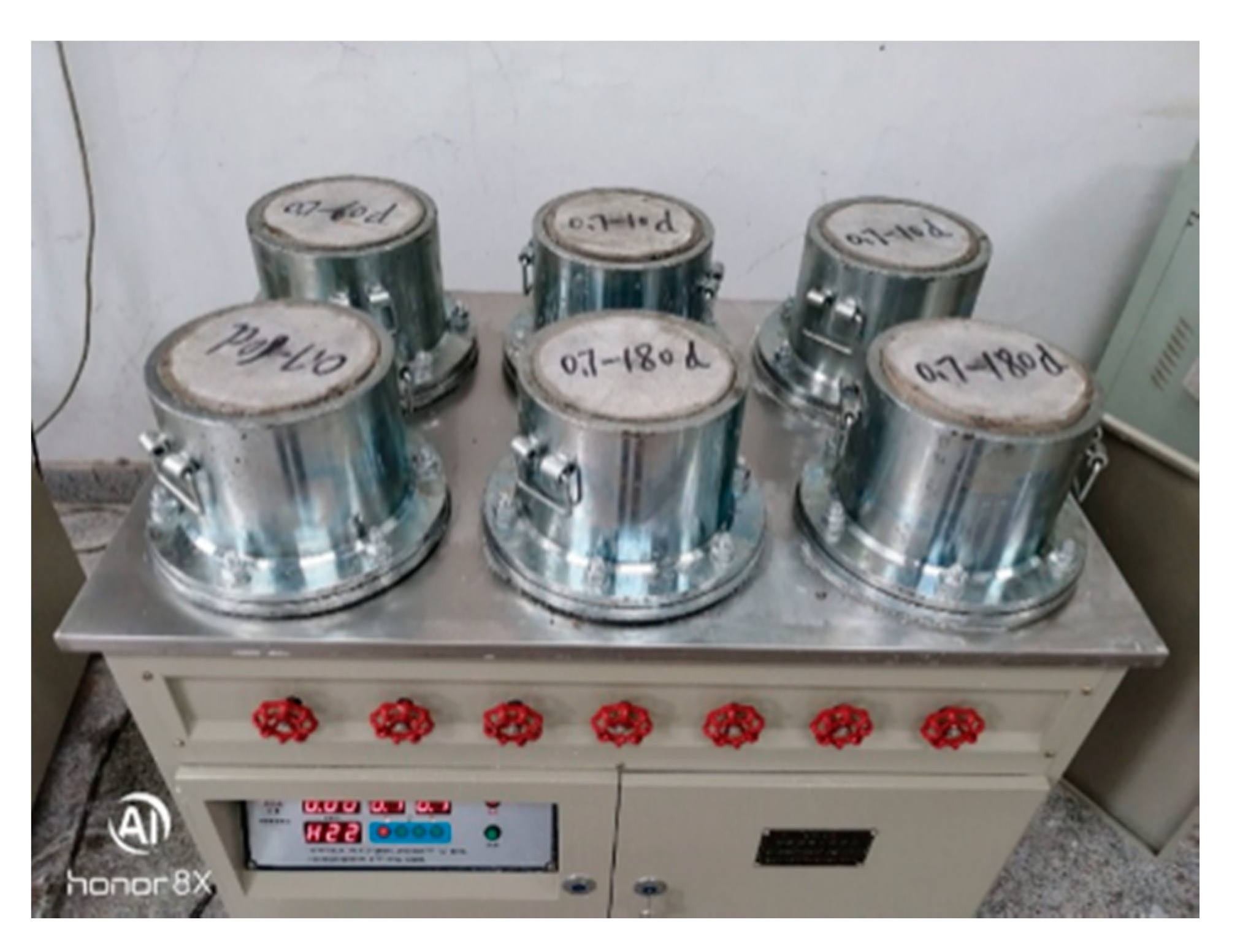







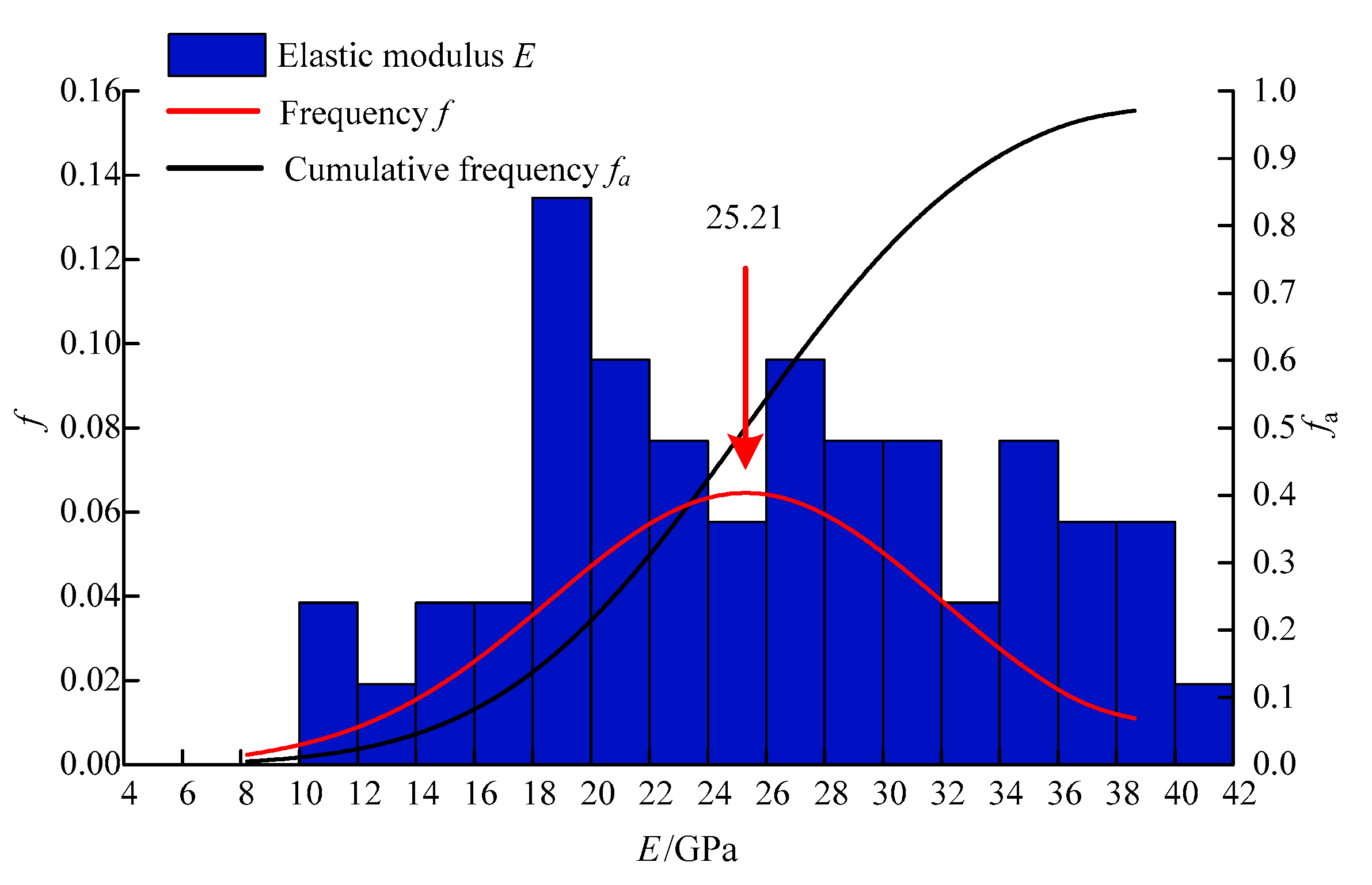
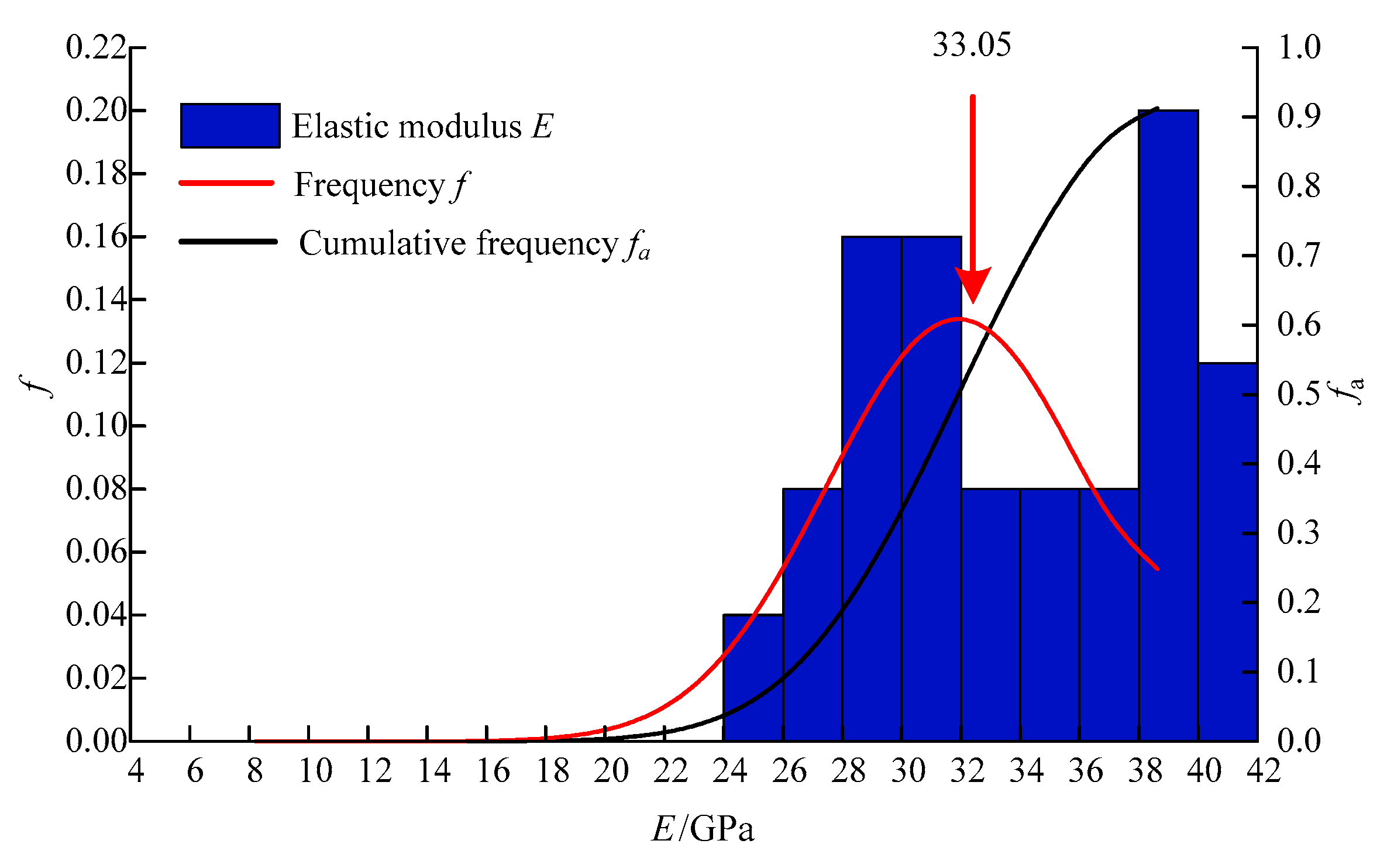
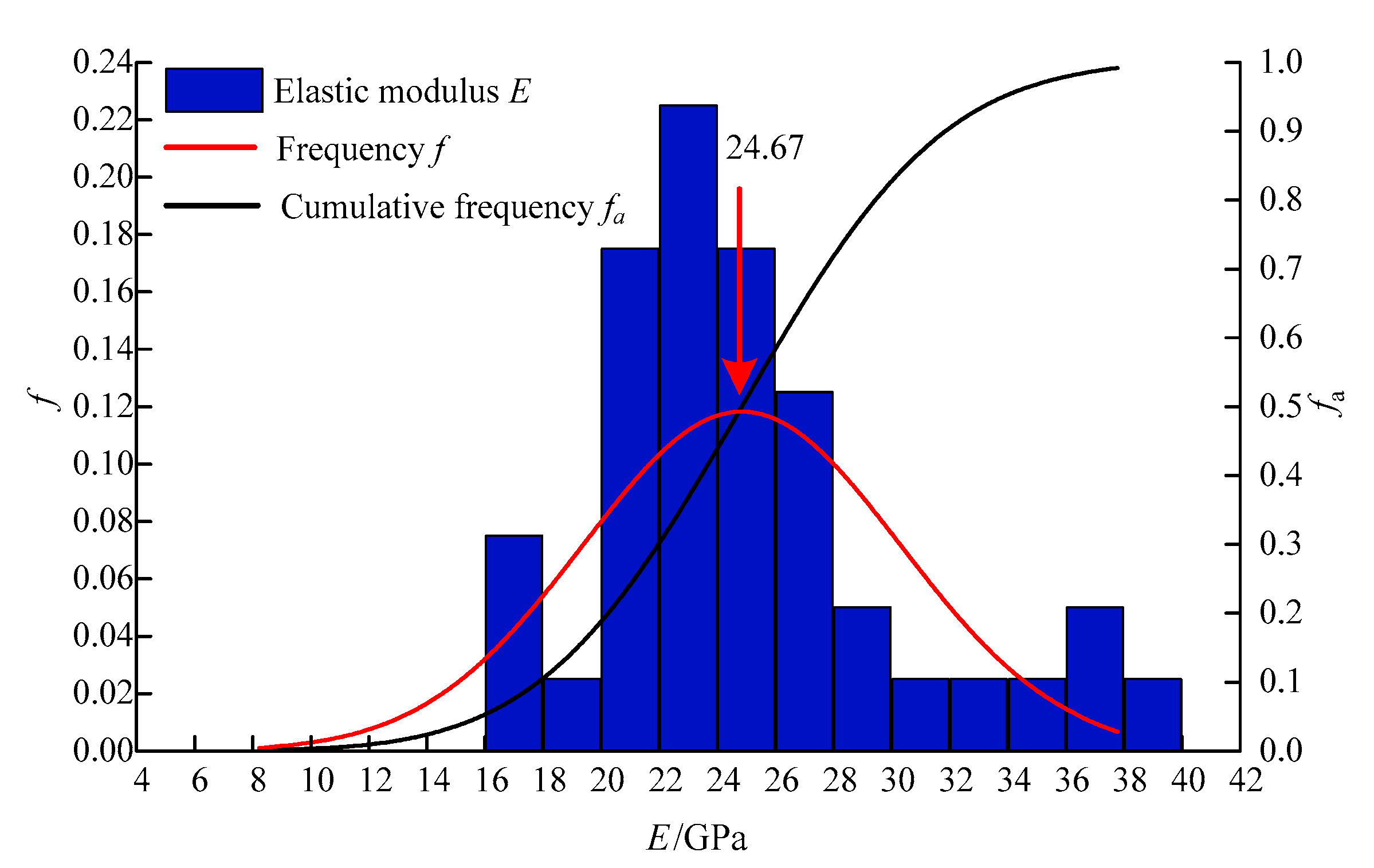
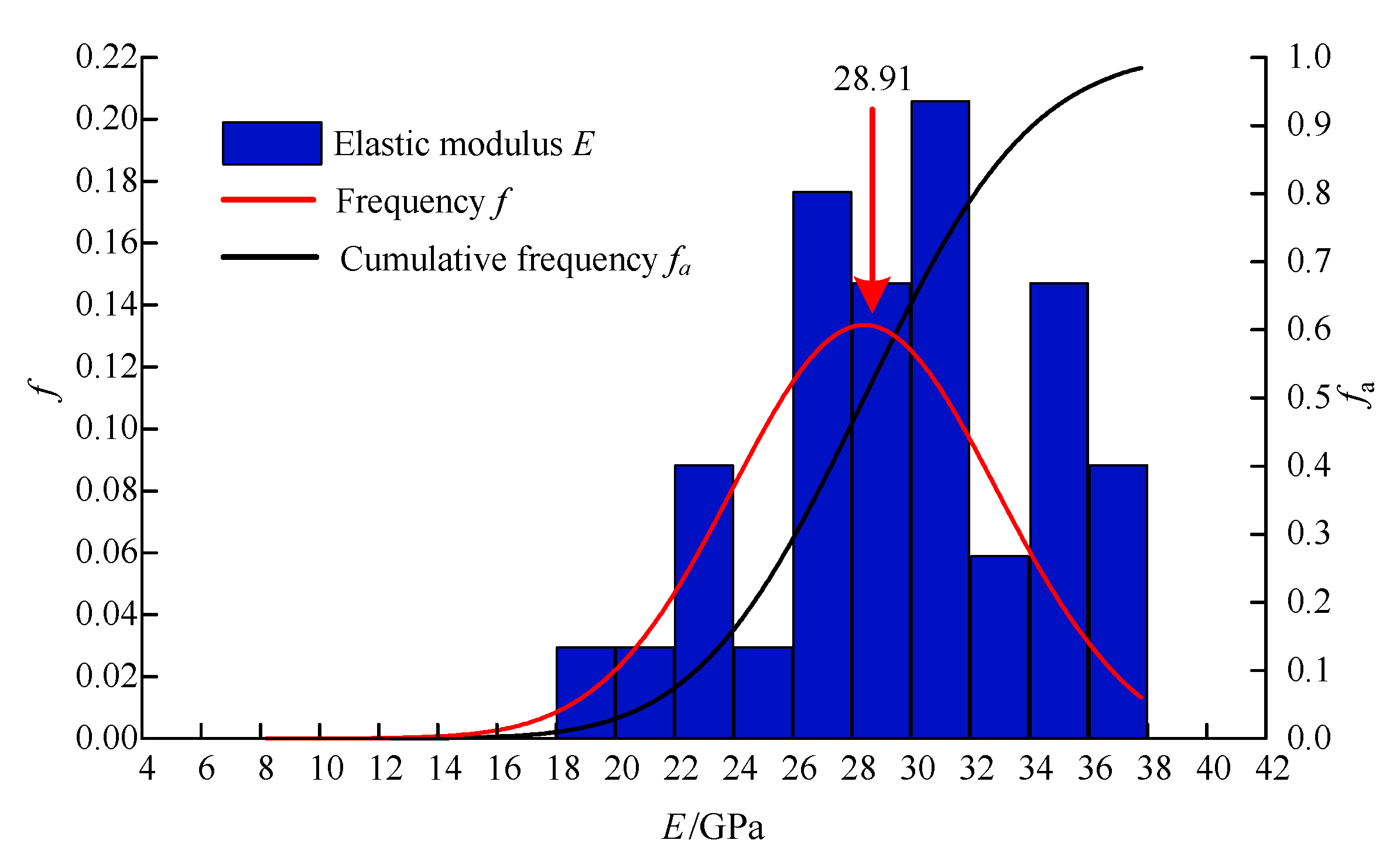
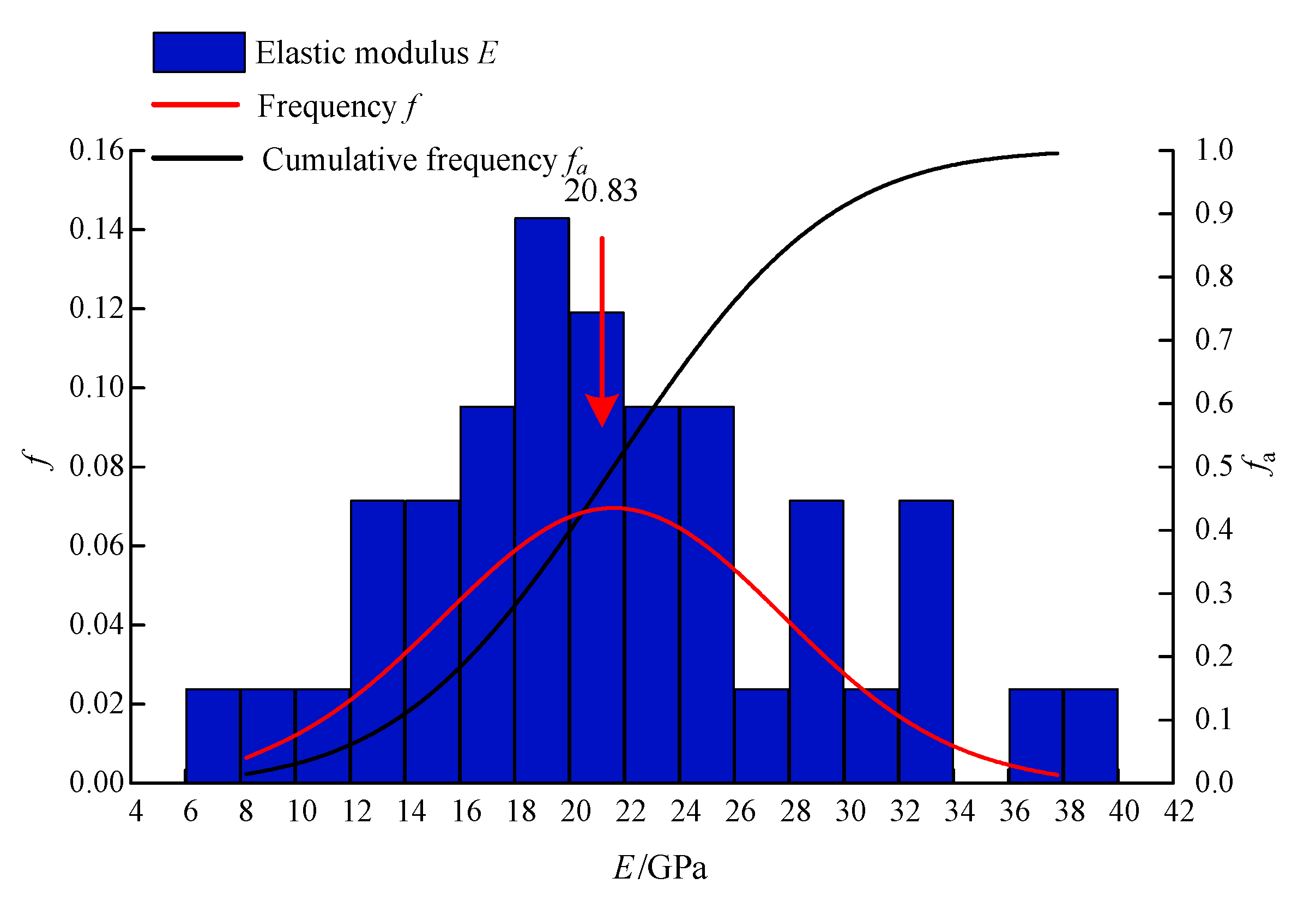

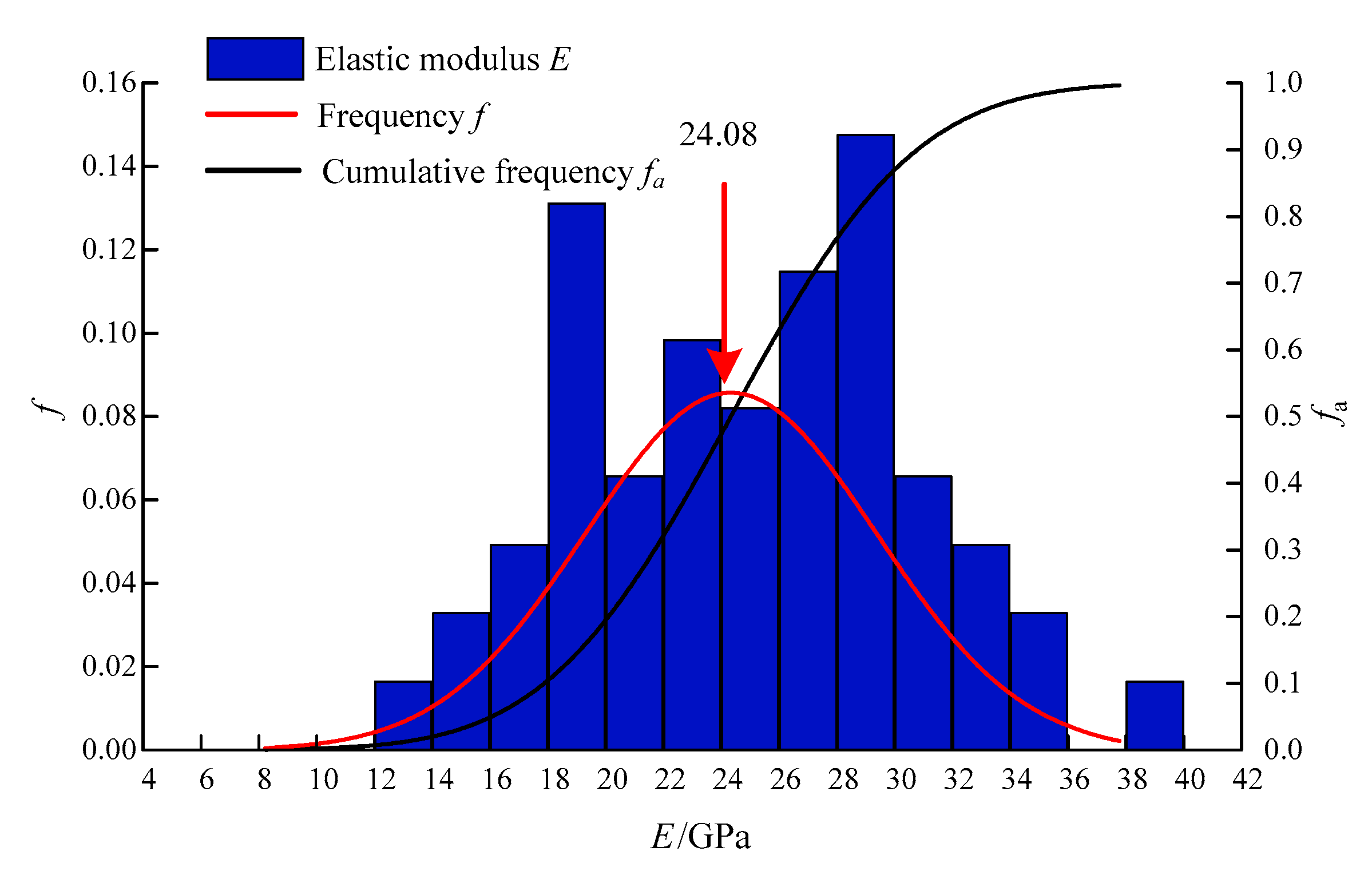

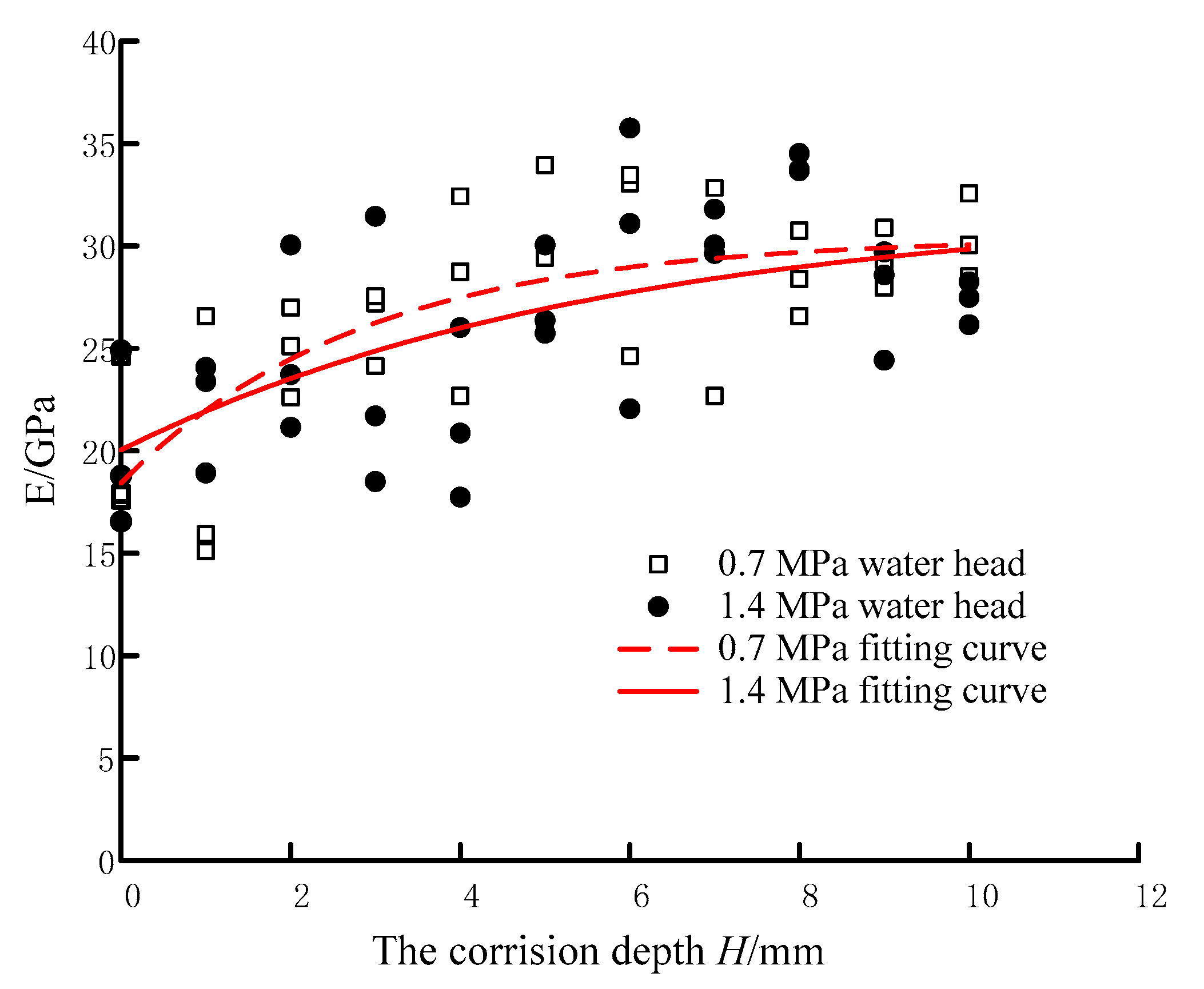
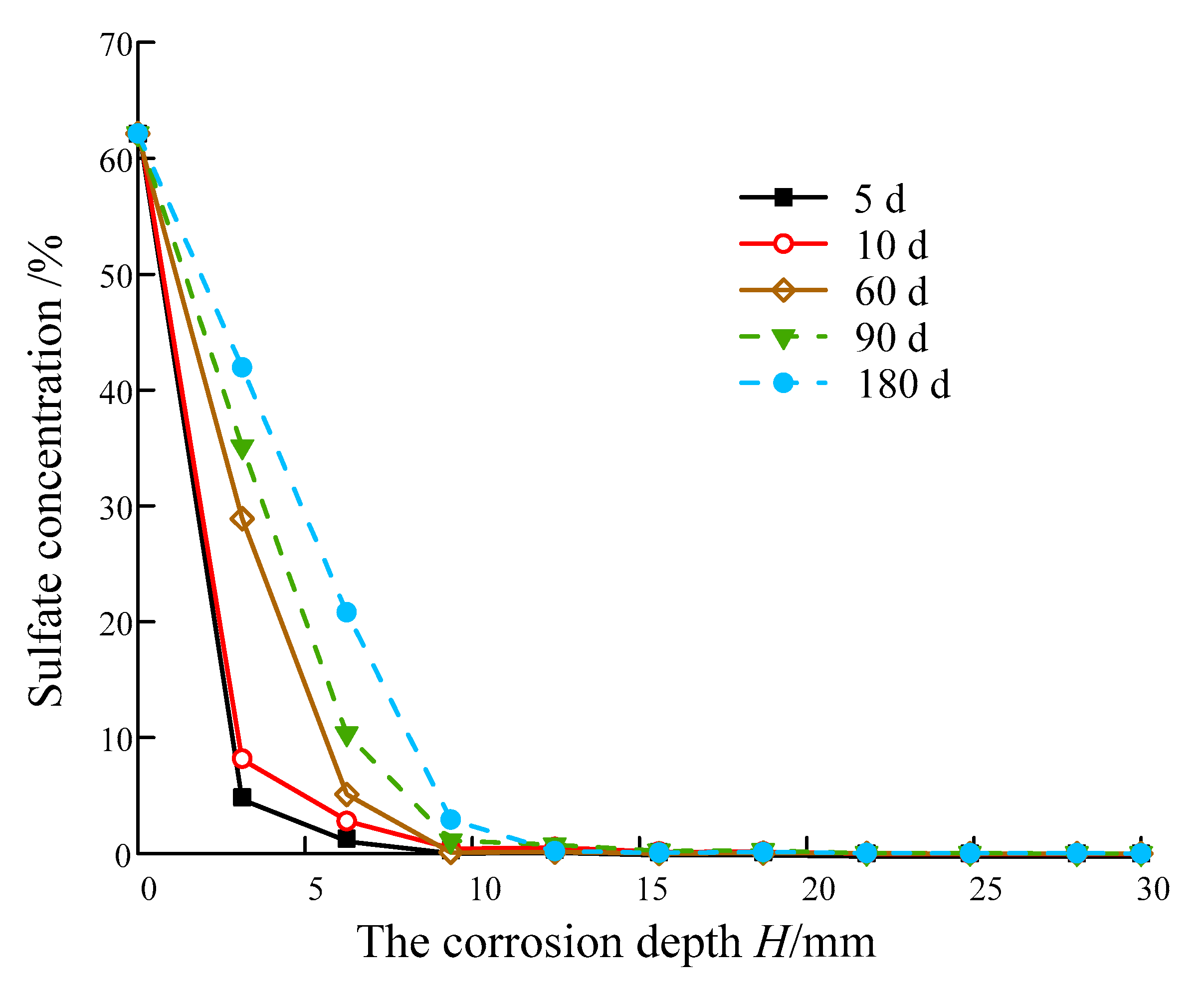

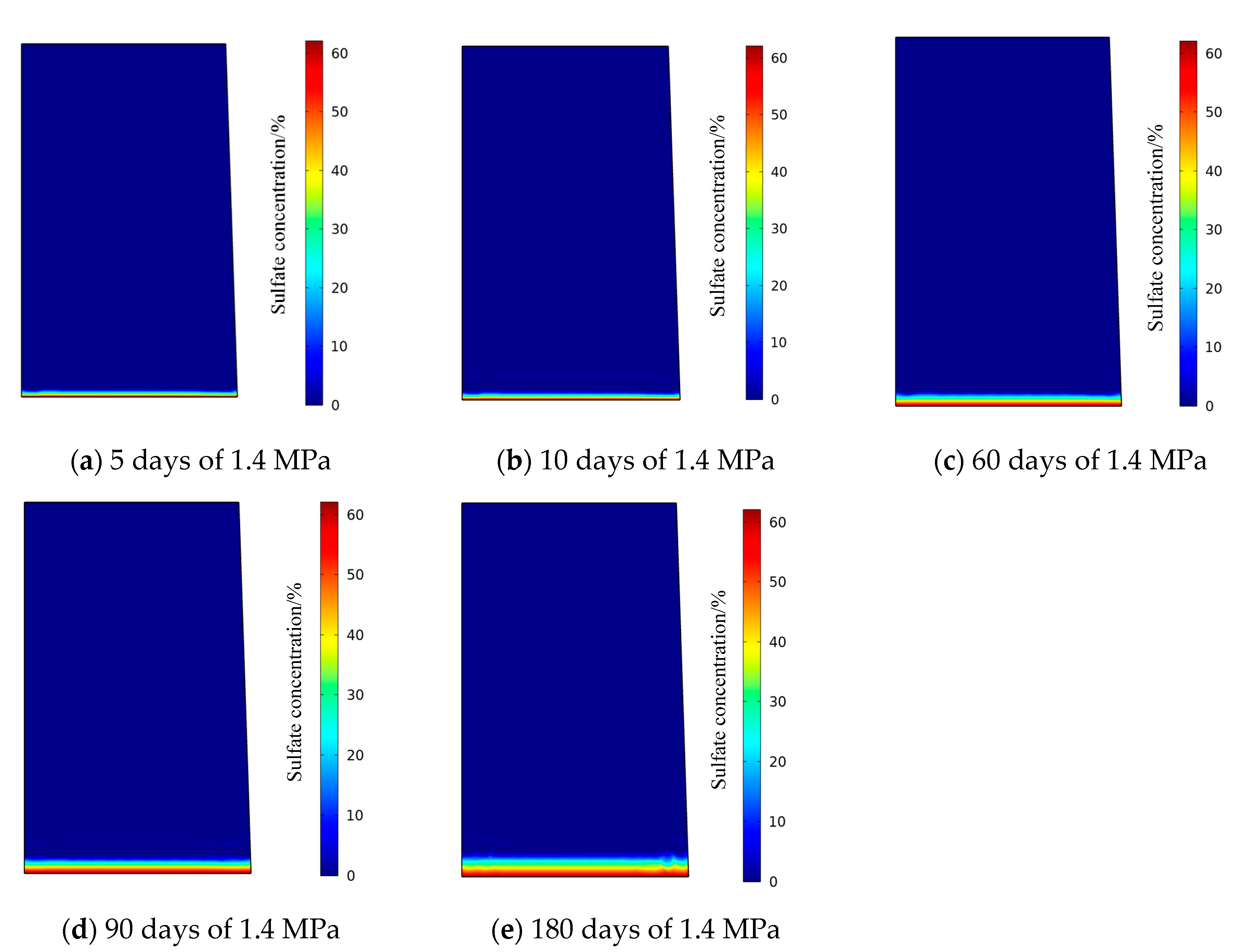
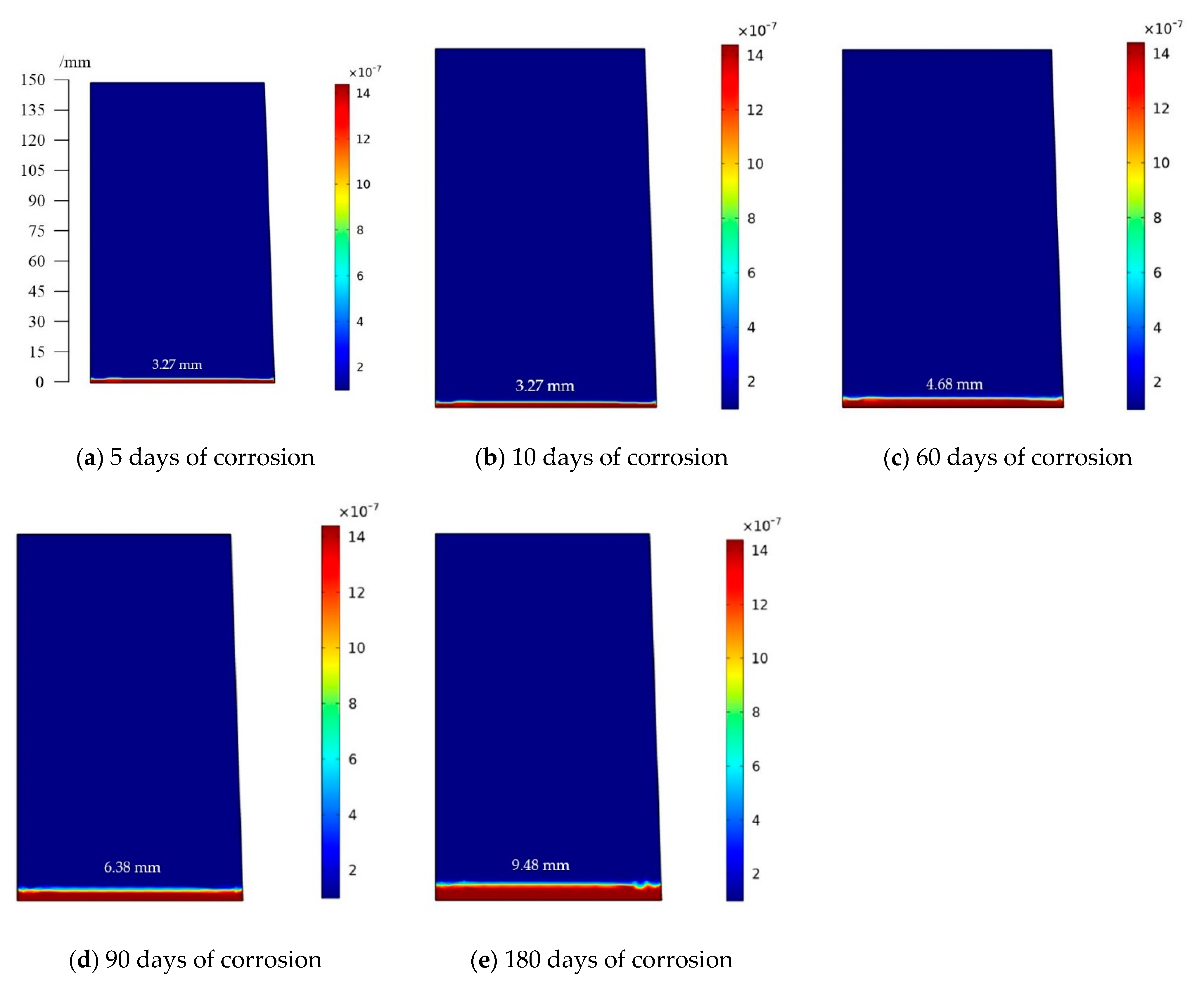
| Concrete Parameters | Value | Mass Fraction (%) |
|---|---|---|
| Strength grade | C50 | |
| Gel material | 420 kg/m3 | |
| Water–binder ratio | 0.35 | |
| Cement | 189 kg/m3 | 15.7% |
| Fly ash | 105 kg/m3 | 8.7% |
| Slag powder | 126 kg/m3 | 10.5% |
| Sand | 775 kg/m3 | 64.6% |
| Water-reducing agent | 4.2 kg/m3 | 0.5% |
| Density | 2395 kg/m3 |
| Water Head p/MPa | 0 | 0.7 | 1.4 | |
|---|---|---|---|---|
| Corrosion Time t/d | ||||
| 0 | 1 | 0 | 0 | |
| 5 | 2 | 2 | 2 | |
| 10 | 2 | 2 | 2 | |
| 60 | 2 | 2 | 2 | |
| 180 | 2 | 2 | 2 | |
| Parameters | Value | Parameters | Value |
|---|---|---|---|
| E (GPa) | 50.55 | 0.15 | |
| v | 0.22 | bp | 2.5 × 10−4 |
| Rt (MPa) | 5.05 | dmc | 0.9 |
| Rc (MPa) | 60.77 | bd | 1150 |
| 2.3 |
Publisher’s Note: MDPI stays neutral with regard to jurisdictional claims in published maps and institutional affiliations. |
© 2021 by the authors. Licensee MDPI, Basel, Switzerland. This article is an open access article distributed under the terms and conditions of the Creative Commons Attribution (CC BY) license (https://creativecommons.org/licenses/by/4.0/).
Share and Cite
Li, R.; Hou, H.; Hu, D.; Zou, Y. Effect of Concrete Micro-Mechanical Properties under the Coupled Corrosion of Sulfate and High Water Head. Energies 2021, 14, 5039. https://doi.org/10.3390/en14165039
Li R, Hou H, Hu D, Zou Y. Effect of Concrete Micro-Mechanical Properties under the Coupled Corrosion of Sulfate and High Water Head. Energies. 2021; 14(16):5039. https://doi.org/10.3390/en14165039
Chicago/Turabian StyleLi, Ruixin, Huiming Hou, Dawei Hu, and Yiquan Zou. 2021. "Effect of Concrete Micro-Mechanical Properties under the Coupled Corrosion of Sulfate and High Water Head" Energies 14, no. 16: 5039. https://doi.org/10.3390/en14165039
APA StyleLi, R., Hou, H., Hu, D., & Zou, Y. (2021). Effect of Concrete Micro-Mechanical Properties under the Coupled Corrosion of Sulfate and High Water Head. Energies, 14(16), 5039. https://doi.org/10.3390/en14165039




